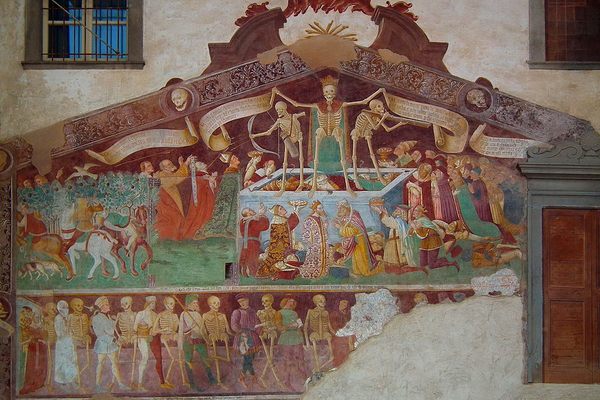About
Cassiglio is a tiny village along Val Brembana, in the Bergamo Alps. As of 2017, it was home to just over 100 inhabitants. For years, the overall trend has been downward, as the young seek better prospects in urban areas, and the old die away. Charming as the surroundings may be, this village is quite ordinary, with one solitary exception: Casa Milesi.
One side of the house, also known as Ca’ Milesi, is decorated with an eye-catching painting. Seven characters are represented in a line, as if they belong to a theatrical representation. Starting from the left, two musicians can be seen, apparently hired to serenade the young, well-dressed damsel at the window. The suitor is the young, elegant gentleman that appears to the right of the window. Both the damsel and the gentlemen are blissfully lost in their romance, ignorant of the ephemeral nature of their existence, but death is lurking surreptitiously behind them and is about to shoot the arrow that will doom them for eternity. Their fate is already sealed, and it can safely be assumed that they will end up chained to death in the same way that the old couple on the right is stooped over and resigned to their inevitable destiny.
Below this macabre painting are some more, rather puzzling figures: a bear, a monkey, a dove, and (what looks like) a dog. If the symbolism of the dove is obvious, that of the other animals is less so, especially in reference to the painting above. A walk to the back of the building reveals paintings of chickens, which also seem rather incongruous. The roof overhang is also decorated with faux attic windows, though one of which, a sinister figure peeps at the observers down below.
Several examples of the danza macabre ("dance of death") can be found throughout Bergamo province, however, even though a skeleton features in the painting on Ca’ Milesi, this is not technically a danza macabre. This painting was done in the 18th century, and “dance macabre” belongs to an earlier period. This painting is, in fact, a “serenade macabre,” in line with the artistic movement associated with Counter-Reformation.
Related Tags
Flavors of Italy: Roman Carbonara, Florentine Steak & Venetian Cocktails
Savor local cuisine across Rome, Florence & Venice.
Book NowCommunity Contributors
Added By
Published
September 13, 2021


































